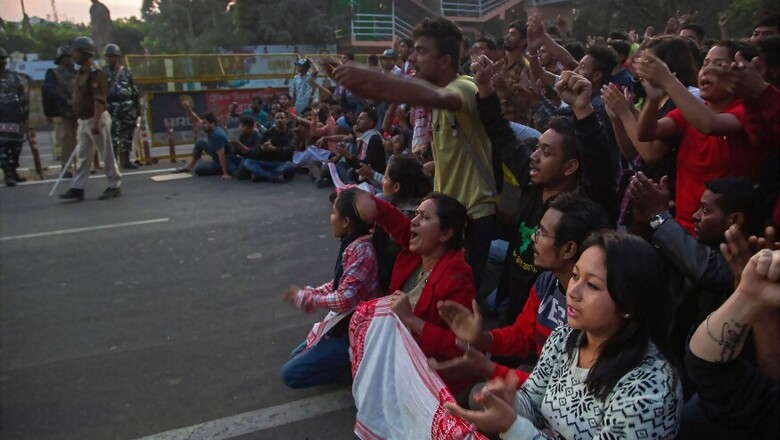
views
After simmering for months, Assam has been rocked by a violent uprising again, tipped over the edge as it has been by the central government pushing the new citizenship law through the parliament.
The new agitation seems to be moving towards the days of non-stop protests witnessed during the anti-foreigner movement of the eighties.
While protests have been held in Tripura and Meghalaya too, they have been the most intense in Assam. The stir continues to engage more and more people and spreads to newer areas every passing day.
Till Wednesday, the movement against the Citizenship Amendment Bill (CAB) was more concentrated in Guwahati and the region in the south bank of Brahmaputra to Tinsukia, which is inhabited primarily by Assamese communities.
The situation began to change on Wednesday evening, when the bill was passed in the Rajya Sabha. Mobile internet was blocked, a curfew was imposed and the Army was deployed to keep the protesters in check. Yet, the morning after saw the anti-CAB stir become far more vociferous. There were more people from all age groups participating in the agitation.
Trees were chopped and highways blocked at several places in the districts of the north bank at Silapathar and Nalbari. Violence also erupted in Guwahati, Dibrugarh and at several other places. The residences of BJP and AGP legislators came under attack along with some offices of RSS.
Chief minister Sarbananda Sonowal's appeal on TV to pacify the protestors and his assurance that Clause-6 of the Assam Accord will safeguard indigenous communities in the state hardly had any effect on the mood of the protestors.
The thousands of protesters in the state, which shares a border with Bangladesh, all say the citizenship law would open the region to a flood of foreign migrants.
"What was the BJP government doing since 2016? What happened to their election promise of identifying and deporting all illegal migrants? Why could Assam BJP leaders not take a strong stand against CAB like their counterparts in other states of the Northeast? Every protestor on the street will ask these same questions," said Tapan Kumar Bhuyan, a middle-aged businessman who marched in Guwahati.
He also referred to the “false promises” made by the BJP and how the National Register of Citizens (NRC) and Assam Accord would be nullified by the new bill.
What is the difference with the agitation of 1979-85?
Unlike the movement in the early eighties against foreigners, the agitation this time around has been more spontaneous and less organised. In the 1980s, there was an apex body consisting of representatives from civil society organisations steering the movement.
Now there are three groups - All Assam Students' Union (AASU), Asom Jatiyatabadi Juba Chatra Parishad and the Akhil Gogoi-led Krishak Mukti Sangram Parishad (KMSS) - that have taken the lead in the protests, besides the students in colleges and universities. There is also a large chunk of participants who are neither students nor affiliated to any of these organisations.
For instance, some regions inhabited by the tea tribes have also joined the agitation against CAB. A village in Dibrugarh inhabited by the community near Lahowal erected barricades on the road and burnt tyres. The protestors had the same reasons for the protests.
In the earlier movement, there were sporadic efforts by the RSS to influence the course of the anti-foreigner agitation. It was extremely unhappy when a large number of Bangladeshi Hindus were detected as fraudulent voters in Mangaldoi Lok Sabha constituency, which was a contributory factor that sparked the agitation.
In the ongoing agitation, the Hindutva organisation has come under attack alongside the BJP and AGP and the possibility of more attacks cannot be ruled out.
For quite a long time, it seems that the organisations leading the campaign were ignorant of the fact that the RSS was the architect of CAB. In the earlier movement, it was the Congress and CPI (M) that had become targets as they were perceived as being pro-migrant by the agitators.
Technology, too, has had a prominent role in the current movement being more decentralised and it has helped in faster mobilisation of people. A middle rung police official in Dibrugarh also attributed the spread of the movement to more areas in the valley to the proliferation of local TV news channels.
Sensing the mood of the people, the government did not waste time in deploying the army in Guwahati and Dibrugarh where flag marches were staged several times Thursday. A decision has also been taken to give charge to the Unified Command, which was created years ago for better coordination among the security forces and police in counter-insurgency operations.
A ‘third force’ in the movement?
The presence of a 'third force' in Jammu and Kashmir was often heard when people hit the streets and pelted stones at the police to protest perceived injustices. Sections of right-wing politicians and government officials were often quick to blame actors from across the border sponsoring the movement and even offering stipends to the agitators.
The same rumours have also been floated in Assam by some BJP-RSS functionaries and officials who feel that "paid miscreants" indulged in the violence that has engulfed large parts of Assam. Most of them have pinned the blame on some politicians from the opposition parties who they feel have doled out huge funds to the select group of agitators to engage in arson.
There is a reason for some BJP leaders to peddle these views. Their assessment on the reaction against the bill has been proved awfully wrong. The party high command was reportedly told that the movement would last only a few days without any deleterious impact on the electoral fortunes of the party. They now need a face-saver and a reason to justify their arguments.
However, there have been episodes that could point to the involvement of miscreants with vested interests in the movement. Some participants in the procession in Guwahati, for instane, had observed some people carried bags with stones which were later pelted at the police near the secretariat.
AASU leaders have also spoken about involvement of a "third force" in the movement seeking to discredit the movement. It did not elucidate but that the student organisation might have been referring to designs by the government to discredit the movement against the CAB.
While the truth about any such involvement cannot be ascertained immediately, what is most certain is the large scale participation in the movement against the CAB in Assam.
Miscreants cannot be held responsible for the grievances that are embedded deep in the psyche of the inhabitants of Assam's Brahmaputra Valley which have accumulated over the past many decades.
The author is a senior journalist in Assam. Views expressed are personal.
















Comments
0 comment